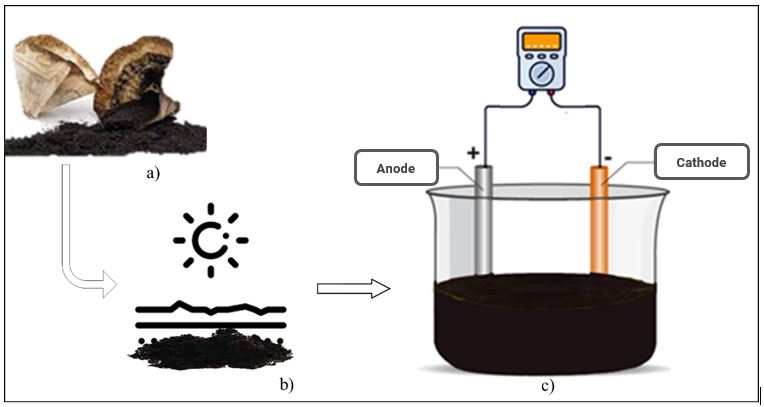The electrical productivity of Arabica coffee grounds battery based on electrode distance and dryness level
DOI:
https://doi.org/10.12928/jrkpf.v9i1.20Keywords:
Alternative Energy, Bio battery, Electrolyte Paste, Arabica CoffeeAbstract
Bio-battery is an alternative natural energy source that utilizes organic compounds to generate electricity. This research uses coffee grounds as an environmentally friendly electrolyte paste. This study aims to identify and analyze the current and voltage produced by the bio batteries with the durability of bio batteries made from Arabica coffee grounds based on electrode distance and dryness level. The method used is a direct measurement of coffee grounds using copper (Cu) and zinc (Zn) as electrodes, further testing of the output current and voltage is carried out every 24 hours. The results showed that Arabica coffee grounds produce a maximum voltage of 1.01 V, a current of 0.49 mA and a power of 0.42 W. Based on these results, Arabica coffee grounds have the potential to be used as bio batteries.
References
I. Pawarangan and W. Jefriyanto. “Identification of Electrical Properties of Bio-battery based on Spent Coffee Grounds.” Bul. Fis. Vol 23 No 2 Bul. Fis.. Aug. 2021.
W. Mrozik. M. A. Rajaeifar. O. Heidrich. and P. Christensen. “Environmental impacts. pollution sources and pathways of spent lithium-ion batteries.” Energy Environ. Sci.. vol. 14. no. 12. pp. 6099–6121. 2021. doi: 10.1039/d1ee00691f.
International Coffee Organization (ICO). “World coffee consumption.” 2021.
S. K. Karmee. “A spent coffee grounds based biorefinery for the production of biofuels. biopolymers. antioxidants and biocomposites.” Waste Manag.. vol. 72. pp. 240–254. 2018. doi: 10.1016/j.wasman.2017.10.042.
A. Afriliana. E. Hidayat. Y. Mitoma. T. Masuda. and H. Harada. “Studies on Composting Spent Coffee Grounds by <i>Aspergillus sp</i> and <i>Aspergillus sp</i> in Aerobic Static Batch Temperature Control.” J. Agric. Chem. Environ.. vol. 10. no. 01. pp. 91–112. 2021. doi: 10.4236/jacen.2021.101007.
R. Nosek. M. M. Tun. and D. Juchelkova. “Energy utilization of spent coffee grounds in the form of pellets.” Energies. vol. 13. no. 5. pp. 1–8. 2020. doi: 10.3390/en13051235.
T. S. Andrade. J. Vakros. D. Mantzavinos. and P. Lianos. “Biochar obtained by carbonization of spent coffee grounds and its application in the construction of an energy storage device.” Chem. Eng. J. Adv.. vol. 4. no. October. p. 100061. 2020. doi: 10.1016/j.ceja.2020.100061.
H. Jung. J. Kang. I. Nam. and S. Bae. “Graphitic Porous Carbon Derived from Waste Coffee Sludge for Energy Storage.” Mater. (Basel. Switzerland). vol. 13. no. 18. p. 3972. Sep. 2020. doi: 10.3390/ma13183972.
H. Darjazi. A. Staffolani. L. Sbrascini. L. Bottoni. R. Tossici. and F. Nobili. “Sustainable Anodes for Lithium- and Sodium-Ion Batteries Based on Coffee Ground-Derived Hard Carbon and Green Binders.” Energies . vol. 13. no. 23. 2020. doi: 10.3390/en13236216.
V. Krikstolaityte. O. E. Joshua. A. Veksha. N. Wai. G. Lisak. and T. M. Lim. “Conversion of Spent Coffee Beans to Electrode Material for Vanadium Redox Flow Batteries.” Batteries . vol. 4. no. 4. 2018. doi: 10.3390/batteries4040056.
J. Y. Wang. P. C. Nien. C. H. Chen. L. C. Chen. and K. C. Ho. “A glucose bio-battery prototype based on a GDH/poly(methylene blue) bioanode and a graphite cathode with an iodide/tri-iodide redox couple.” Bioresour. Technol.. vol. 116. pp. 502–506. Jul. 2012. doi: 10.1016/J.BIORTECH.2012.03.083.

Downloads
Published
Issue
Section
License
Copyright (c) 2022 Ishak Pawarangan, Martina Pineng, Saiful Achmad Anum

This work is licensed under a Creative Commons Attribution-NonCommercial 4.0 International License.







